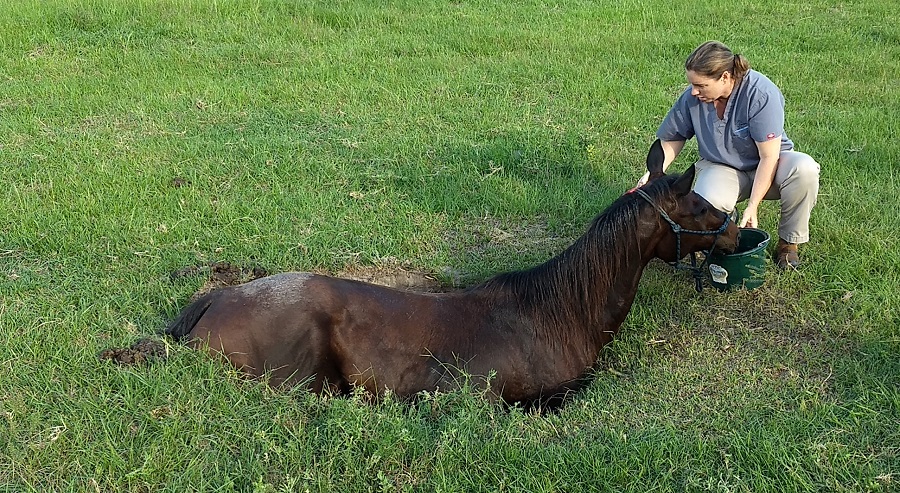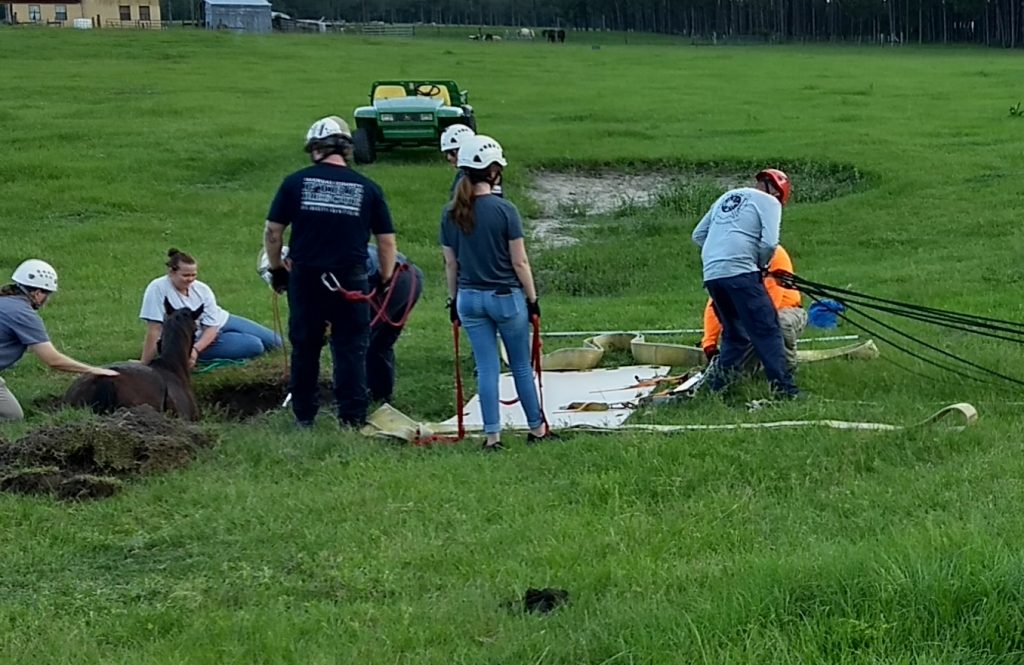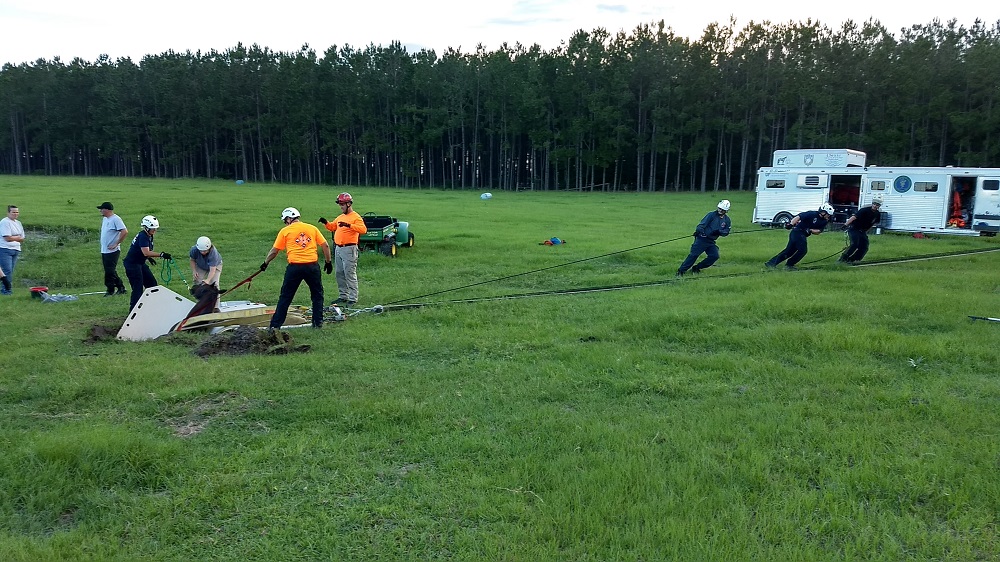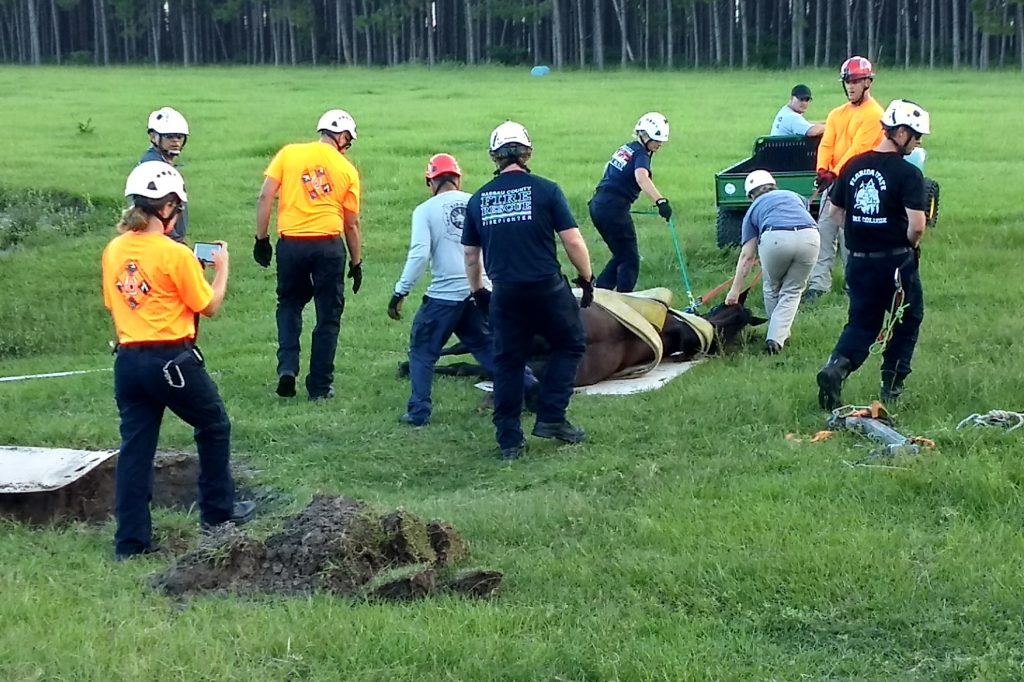
Large Animal Emergency Rescue
Tuesdays with Tony
My Docs love to have adventures on weekends. Normally it’s injuries that make for the most interesting stories, but this past weekend it was a sinkhole and a large animal emergency rescue. We have had a ton of rain so far this year in Florida. Combine that with some other factors, and sinkholes become a problem. This past Saturday a sinkhole opened up in a pasture where a blind patient of Springhill Equine lives, and she ended up in it. And that’s where my story begins.
The Situation

Springhill Equine got the call very shortly after the owner found this poor girl in the sinkhole. Luckily, this was about a horse-sized hole, and it wasn’t terribly deep, as you can see. After some questioning, it seemed she had, at most, been in there since morning (it was now late afternoon), and she was interested in food and water. She didn’t seem to have any injuries, and was mentally pretty OK about everything. This means the safest place for her to be was in the hole until help could arrive. Dr. Lacher told the owner to keep offering water and grain, keep her as calm as possible, and she was headed that way (as soon as she finished treating the colic she was at, because horses get together and plan emergencies). Dr. Lacher hung up the phone and called the University of Florida VETS team. This is like calling MacGyver out to your emergency. They get called when animals are stuck and need help getting unstuck. Like in a sinkhole, trailer accidents, swimming pool, or recently, a pug in a 30 foot hole. You get the idea.
I’ll just do this thing…
There’s a temptation when you see this horse is this hole to think “We can just dig that out.” Don’t. It seems like an easy solution, but it can make things a lot worse. First, in this situation the hole had just formed. The owner knows it wasn’t there as little as 18 hours before finding the horse. Bringing in a backhoe, or other heavy equipment, could have caused unsettled ground to unsettle more. Second, horses and large machinery don’t mix well. My not so humble advice: call my Docs, get their thoughts, then get them there before you do anything!
Technical Large Animal Emergency Rescue (TLAER)
TLAER is what the UF VETS team does. It’s the use of straps and pulleys, and A-frames, and all kinds of stuff to get live animals out of the crazy places they get themselves without further harming them. They say curiosity killed the cat, but I rather think that statement could include horses and cows. Back to TLAER. Training starts with classroom work on how animals respond to scary situations (Pro Tip: we usually go with either fight or flight, and sometimes both at the same time), concepts in leverage, and how to attach animals to said leverage devices safely. Animals, kind of like people, come in all different shapes and sizes. To get them out of tight quarters, straps and webbing are often used. There are safe places these straps can go without causing harm, and there are places they can go and cause tremendous pain and injury.
Part two of training involves practicing on model horses. Not model as in super model, model as in life-size plastic model. It takes a lot of practice to formulate a plan for how best to get the horse, or cow, or pug, out of wherever they’re stuck in the safest, most efficient manner. It also takes practice putting straps on, setting all the gear up and working as a team. This means there’s the initial training, and then there’s lots and lots of practicing so when it’s a real emergency the team is ready!

Up and Out
The UF VETS team decided that for this mare, the best answer was to slide her out. This meant digging the hole out a little further so that a large heavy plastic mat could be placed next to her. Luckily, this wise girl took it like a champ. Dr. Lacher was standing by with sedation in case she got nervous about all the goings on. Next, the mat was put in the hole so that it was next to her, with another on the ground just outside the hole. Webbing was then placed around her just behind her front legs, and just in front on her hind legs. Again, this mare was amazing through the entire process! She let them place the webbing with reassurance from her owner that it was all OK. Once the webbing was placed, Dr. Lacher sedated her.

The hope was that she would let us get this done with just sedation, but Dr. Lacher was ready with the knocked-out-all-the-way drugs if they were needed. While they were letting the sedation have a few minutes to kick in, the webbing was attached to a super cool block and tackle system which gave the humans enough leverage to pull the horse out without having to rely on heavy equipment. Sedation having kicked in, they gave hoisting the mare a try, but she wasn’t having it. Can’t say I blame her!!! So the knock-out drugs were given. Once she was asleep, she was hoisted up and out of the hole in about 5 minutes, and gently placed on the plastic mat on solid ground. An ATV was hooked up to this mat, and she was moved a safe distance away from the hole to wake up.

Teamwork!
It’s hard for a cat to say teamwork makes the difference, but there you have it. This is an excellent example of a case where teamwork made all the difference. It took an amazing owner, a veterinarian, and an entire team of dedicated large animal emergency rescue folks to get this mare safely out of the hole. I teared up a little thinking about how they all worked together to make the world a better place for horses!
Want more Tony wisdom? Scroll down a teeanie, tiny bit further and subscribe to my blog. So easy, even a human can do it.
Tuesdays with Tony is the official blog of Tony the Office Cat at Springhill Equine Veterinary Clinic in Newberry, Florida. For more information, please call us at (352) 472-1620, visit our website at SpringhillEquine.com, or follow us on Facebook!
[jetpack_subscription_form title="Subscribe to Whinny's Wisdoms"]
